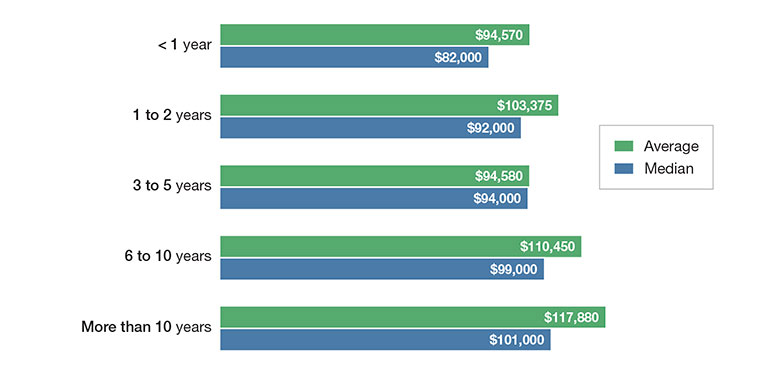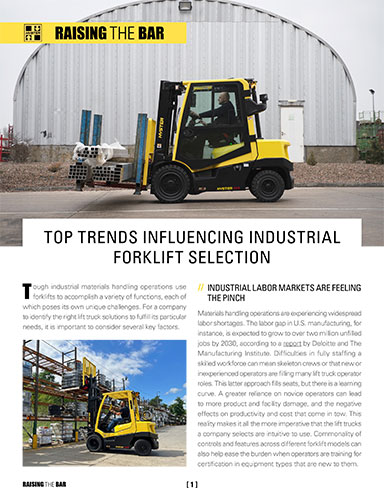Logistics Labor: Increasing retention
To better manage through the constrained labor market, logistics operations are courting more women and other diverse job candidates; ramping up their training programs; investing in automation; and ensuring that positions offer the work-life balance that many new recruits are seeking.
Also in April, average hourly earnings rose 0.5% for the month and increased 4.4% from one year earlier—both higher than expected. Even in the face of potential economic headwinds, rising interest rates and high inflation, organizations are both hiring and paying more for that talent.
Logistics salary by years in present position 
While some industry sectors are downsizing their labor forces, logistics talent remains elusive in the current job market. To address the problem, companies are stepping up their recruiting and retention processes; universities and trade schools are enhancing their curriculum to ensure graduates are ready to fill the open positions; and industry associations are helping their members by providing more labor-focused support, courses, and workshops.
Abe Eshkenazi, CEO at the Association for Supply Chain Management (ASCM), says the global pandemic drove a lot of changes in the logistics field, including the boom in e-commerce orders, demand for faster delivery and the persistent supply chain shortages.
“As a result of these and other factors, the logistics field as a whole has probably taken a much bigger hit than say, manufacturing has,” says Eshkenazi. “With the significant transformation that e-commerce imposed on many manufacturers and distributors, the business model changed and logistics hasn’t caught up with all of those changes yet.”
Transitory jobs vs. careers
The perception that logistics and transportation jobs are more “transitory” in nature and less career-oriented is also influencing companies’ ability to recruit and retain employees.
That’s because someone may view a warehouse job as something they can do now, while they wait for a better opportunity to come along later. Eshkenazi says that the lack of formal education for individuals entering the logistics industry is another roadblock.
“As a result of these and other factors, the logistics field as a whole has probably taken a much bigger hit than say, manufacturing has…With the significant transformation that e-commerce imposed on many manufacturers and distributors, the business model changed and logistics hasn’t caught up with all of those changes yet.”
These stumbling blocks can turn into major issues in a field where 46% of Peerless Research Group’s 2023 Logistics Management Salary Survey respondents say that they’re “always open” to finding better job opportunities. And while 31% say they’re happy in their current positions, 20% are passively looking for new career opportunities and 3% are actively looking.
To fill empty seats, companies are courting more women and other diverse job candidates, ramping up their training programs, and ensuring that positions offer the work-life balance that many new recruits are seeking.
Organizations are also focusing on employee engagement—which Gallup says slumped to a seven-year low in 2022, with just 32% of employees feeling “engaged” in their work—and coming up with new ways to keep their employees satisfied, in place, and productive.
“The reality right now is that workers have choices,” says Tom Derry, CEO at Institute for Supply Management (ISM). “I know of one company that employs about 25,000 people in the logistics and supply chain space, and they had 80% employee turnover last year because people are able to find similar job opportunities next door, down the street, or across town.”
In those situations, workers will jump ship for an additional one or two dollars per hour. To stem the outflow, companies are offering signing bonuses, tuition credits and other perks that help them position themselves as “employers of choice” in this tight labor market.
“They’re saying ‘come to us and we’ll pay you a competitive wage and help you acquire new skills and advance in your career,” says Derry. “That seems to be an effective strategy.” To advance their careers, 53% of professionals that Peerless Research Group surveyed rely mostly on personal or social networking; 28% have earned industry certifications; and 22% took classes or earned a degree in business or a related field. Eighteen percent of respondents say that joining an industry or professional association helped them advance their careers, while 15% say taking classes or getting a degree in transportation, logistics or supply chain played important roles in their career advancement. The good news is that providing this enrichment to employees doesn’t cost much, but the payoff can be significant, according to Derry. When they’re constantly learning and growing, employees are more likely to be productive and engaged in their work. They’ll also come up with new ideas and solutions, and produce the high-quality work that leads to higher customer satisfaction and improved bottom lines. “The benefits of [continuing education] as perceived by the employee can be significant, and particularly for that certain segment of associates that you really want to keep on board [i.e., those career-minded individuals who are interested in advancement],” Derry says. “They’re not just showing up to work a shift and collect a paycheck— they’re thinking about the future.”
“The reality right now is that workers have choices…I know of one company that employs about 25,000 people in the logistics and supply chain space, and they had 80% employee turnover last year because people are able to find similar job opportunities next door, down the street, or across town.”
A different story than last year
As she surveys the current state of the logistics labor market, Sarah Banks, managing director at Accenture, takes a glass-half-full view on the situation. Sure, labor is still difficult to find and retain, but things are better than they were just a year ago.
“It’s definitely a different story than last year, when we were in the thick of all of the supply chain disruptions,” Banks points out. “If you look across the supply chain functions—inventory management, warehousing, transportation—there’s definitely stabilization. Not to say that every problem has been solved, but things have stabilized.”
That leveling off has somewhat stemmed demand for logistics labor and helped job recruiters sleep a little better at night.
“Recruiters are taking some breaths and assessing the situation, versus being in the ‘frantic hiring mode’ that they were in last year,” says Banks, who adds that this shift is only about a few months old. And on another positive note, she says labor market retention is also slowly improving.
“The churn that companies in the logistics sector were facing is not at the same level that it was at last year,” Banks explains. “People are staying in place longer, and even in those roles that are tougher to fill and that don’t have incredibly high retention rates to begin with.”
To increase the odds that employees will stay with them, companies are offering flexible schedule options and giving workers more autonomy, knowing that those individuals put high value on being able to take a Friday afternoon off to attend a child’s soccer game or school function.
Logistics job pursuit

Logistics and warehouse managers are also using more technology to ensure that all shifts are covered. For example, they’re using artificial intelligence (AI) to infuse more logic into the shift scheduling process. Banks says the AI helps companies match the right skilled employees with the right positions and open shifts.
Citing a recent Accenture study on the digitalization of logistics, Banks says that most of the 600 supply chain professionals polled said a digital focus was “absolutely mandatory” to protecting the future of their organizations.
This is changing how companies hire and the skills that they’re recruiting for. A logistics operation, for instance, needs associates who understand data and analytics, and that can tap into the power of advanced technologies like AI, the Internet of Things (IoT) and machine learning.
“Going forward, and within a very short period of time, we’ll see a hockey-stick curve in terms of the movement from using manual processes over to those that are supported by automation,” says Banks. “That could include robotics applications or AI-assisted processes, but, either way, your workforce is going to be different.”
What’s coming next?
From his vantage point as CEO of ACSM, Eshkenazi says the overall focus on supply chains, logistics and transportation is only going to sharpen in the next few years. And even as they adopt more warehouse automation and robotics, companies are going to need skilled individuals to work along side and run the automated equipment.
Organizations are also opening new rural and urban distribution centers—moves that create additional labor challenges, depending on the specific region. “The need for talent exists in nearly every region of the United States and across every aspect of the delivery model,” says Eshkenazi. “Having competent, capable individuals will be critical to helping companies design and enable these organizations to respond to the changes.”
To best respond to the changes that are in the air, companies will also have to sharpen their diversity, equity and inclusion (DE&I) pencils and create workplaces that support all of their valued employees.
“We need to open up our aperture on DE&I. This has been a challenge in our industry, and specifically for career-oriented individuals,” says Eshkenazi. “If candidates can’t ‘see’ individuals who look like them, they may not recognize the potential career opportunity that lies before them.”













